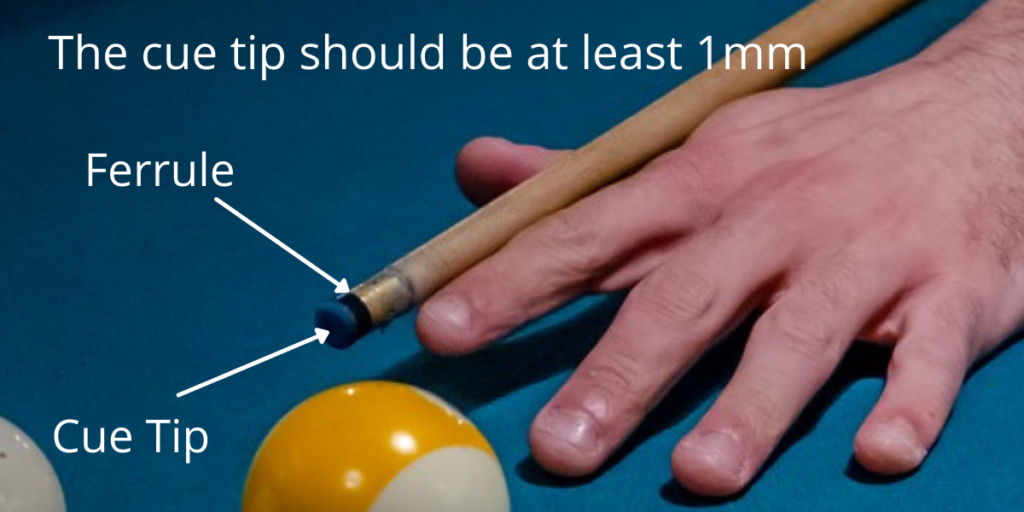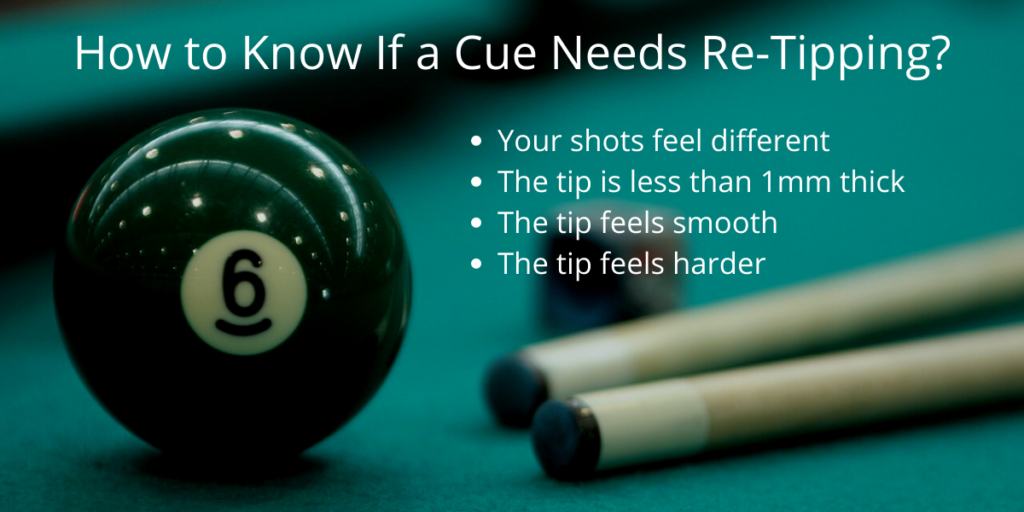If you’ve recently purchased a pool or snooker cue, or you’ve had it for a long time then you’ll need to know how long the tip lasts to make sure you are getting a consistently high level of performance from your cue. In this article, I’ll explain how long pool cue tips last, why they become worn, and how to know when it needs replacing, plus some maintenance tips at the end to make the tip last longer.

How Long Do Cue Tips Last?
On average, pool and snooker cue tips usually last around 6-12 months for serious players who are using the cue several times per week. For more casual players who make only be using their cue once a week, the tip will usually last several years before it needs replacing.
Why Does the Tip Wear Out?
It’s really important to consider the condition of the cue tip because it’s really the most important part of the cue, being the only component that makes contact with the cue ball. This means the texture and shape of the cue tip will impact every single shot you make.
Every time you hit the ball with your cue, you are putting it under stress. This will cause the tip to squash and flatten over time. It can also cause it to become misshapen if pressure is applied unevenly in a repeated fashion.
Also, every time you chalk your cue (which is before every shot for many players), you soften the tip. The abrasive effect of the chalk causes the tip to wear down and again, flatten. This lack of texture can make it difficult to play shots properly.
How quickly a cue tip wears down really depends on the following factors:
- Playing frequency and style
- Tip type (hardness)
- How often it is maintained
Tip Type Matters
Not every pool and snooker cue tip is made evenly, and some will wear out faster than others. Most cues use leather tips, but they vary in their hardness. Softer tips will flatten more quickly so need replacing more frequently than harder tips. So it is often the case that a softer tip will actually become a harder one over time as the leather compacts due to the flattening effect of the cue ball.
Check out my article on hard vs soft cue tips to learn more about the pros and cons of each.
Replacing the Cue Tip
You can replace the tip of a cue when it becomes worn and flat, or too hard. This is much cheaper than replacing the entire cue and the tip will wear out much faster than any other part of the cue so it is recommended to just replace the tip when necessary.
How do you know when the tip needs replacing?
You can tell if a cue tip needs replacing because it will feel either very smooth or be very flat. It the tip has worn down to 1mm of less from the ferrule, then it needs to be replaced. You may also recognise when the tip needs replacing if you notice a change in the way your shots feel.

Players who prefer a softer cue tip are likely to notice this change in feel more than players who select a harder cue tip from the offset. There will not be a dramatic change in the hardness of an already “hard” cue tip, whilst the change will be far more noticeable with a softer tip.
It’s a good idea to check your cue tip at around the 6 month sign for signs of wear, such as it becoming much smoother, harder or flatter. It can be hard to detect if the shots feel different to when you first used the tip, as the change will occur gradually over a period of time.
That’s why it’s a good idea to measure the tip of your pool or snooker cue when it is re-tipped, or when purchasing the cue initially if it has never been re-tipped, then you will have some kind of reference point and know it the tip has become considerably flatter.

How much does it cost to re-tip a cue?
It usually costs around $10-15 to re-tip a cue and will take less than half an hour. You can replace the cue tip yourself or take it to your local store to be replaced. If you are not fully comfortably re-tipping and shaping the cue yourself, then it’s always better to take it to a professional because your playing experience will suffer massively if the job isn’t done properly.
Here is a YouTube video demonstrating the process of re-tipping a cue.
How to Maintain a Cue Tip
There are a few reasons which will cause a cue tip to wear out faster:
- Frequent playing
- Improper technique
- Lack of maintenance
There’s not much you can do about the first reason. With regards to improper technique, I’m not talking about being the best player in the world, I’m more just talking about being sensible and reasonably accurate with your shots. If you’re reading this article, then the chances are that your technique will not be causing your cue tip to wear out faster.
The main thing you have control of though, is how you maintain your cue. Spending a bit of time to look after the cue tip properly is worth it in the long run as it’ll mean it needs replacing a lot less often. Here are some tips.
Scuff Your Cue Tip
Scuffing, is the name given to the process of roughening the cue tip. Worn out cue tips typically feel smoother over time, and scuffing the tip will essentially reverse this process and give you a fresher cue tip surface without replacing it. A rougher cue tip allows it to hold more chalk to prevent mis-cues.
Some players use sandpaper for this process but it is not really recommended. Instead, pick up a proper scuffer like this Cuetec Bowtie 3-in-1 Cue Tip Tool on Amazon. This will allow you to properly scruff and re-shape the tip for the best results.
Also, when your cue becomes flatter over time, you can reshape it using the same tool listed above. This will also give you the experience of playing with a newer tip without actually re-tipping the cue.
Do Not Over-Maintain Your Cue
Scuffing and re-shaping a cue is a good idea if you want to get the experience of playing with a fresh cue tip, but without actually re-tipping the cue. However, if you do it too often then the tip will actually need replacing sooner.
These processes will wear down the cue tip, and whilst they get the texture and roundness of the tip back, they will make it thinner in the process. There is still a limit to how many times you can scuff and re-shape the cue. When it’s less than 1mm thick, it’s time to get a new one.
Make sure you only scuff and re-shape your cue when it’s absolutely necessary. This may be every few months or every couple of years, it really depends on how much you play and the cue tip itself. There’s no magic number here.
Consider How You Chalk the Cue
I mentioned earlier that chalking the cue will cause the tip to become smoother over time which isn’t what you want. This is all down to the mildly abrasive nature that the chalking process has. Choosing a smoother and less gritty chalk is going to help here, as well as being gentle when you actually apply it rather than scrubbing at the cue tip with excessive force.
Store the Cue Properly
Excessive humidity and heat will cause the cue tip to wear out more quickly, and they will also have a negative effect on the ferrule and wood. Make sure you store your cue in a case and keep the case in a cool, dry area which is free from frequent temperature changes.